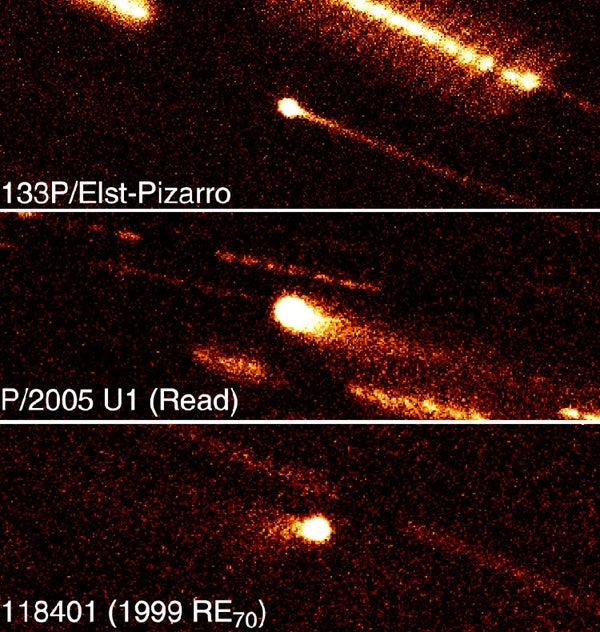A trio of comets orbiting in the main asteroid belt between Mars and Jupiter probably formed there, say University of Hawaii astronomers Henry Hsieh and David Jewitt. They dub these bodies “main-belt comets” and estimate up to 150 similar objects may exist. They also suggest these objects may solve the enduring mystery of how the young, desiccated Earth received its bounty of water.
“The main-belt comets are unique in that they have flat, circular, asteroid-like orbits, and not the elongated, often tilted orbits characteristic of all other comets,” Hsieh says. “At the same time, their cometary appearance makes them unlike all other previously observed asteroids. They do not fit neatly in either category.”
The observations that clinch the case occurred November 26, 2005, when Hsieh and Jewitt saw dust ejecting from asteroid 118401 using the 8-meter Gemini North Telescope on Hawaii’s Mauna Kea. Follow-up observations a month later confirmed the asteroid was showing unambiguously comet-like behavior.
The granddaddy of the new comet class is a body named Elst-Pizarro whose double life mystified astronomers. Elst-Pizarro, found in 1979, was first classified as an asteroid; it’s number 7968. Then, in 1996, discoverers Eric Elst and Guido Pizarro using the European Southern Observatory’s 1m telescope in La Silla, Chile, found it emitting dust like a comet. Thus began asteroid 7968’s “dual citizenship” as Comet 133P/Elst-Pizarro.
Although Elst-Pizarro’s puzzling activity disappeared between 1997 and 2001, Hsieh and Jewitt saw dust emission in 2002. Since 2003, Elst-Pizarro has appeared steadfastly asteroidal.
The second main-belt comet identified is Comet P/2005 U1, discovered in October 2005 by Michael Read with the Spacewatch 0.9m telescope on Kitt Peak, Arizona. There’s no doubt the object is a comet, but its orbit lies squarely in the main asteroid belt.
Then, a month later, Hsieh and Jewitt witnessed asteroid 118401 emitting dust.
“The discovery of the other main-belt comets shows that 133P/Elst-Pizarro is not alone in the asteroid belt,” Jewitt says. “Therefore, it is probably an ordinary — although icy — asteroid and not a comet from the outer solar system that has somehow had its comet-like orbit transformed into an asteroid-like one. This means that other asteroids could have ice as well.” The study was published online by ScienceExpress March 23 and is scheduled to appear in the journal Science this month.
“If there were only one, it could be a fluke, but they’ve got three,” says Brian Marsden, director of the Minor Planet Center at the Harvard-Smithsonian Center for Astrophysics in Cambridge, Massachusetts. “There’s support in numbers, isn’t there? Clearly, the whole thing has to be investigated further.”
Traditionally, astronomers envisioned asteroids as marching through the asteroid belt on nearly circular orbits, while comets move every which way, taking eccentric paths often tilted steeply to the plane in which the planets move. “The line between comet and asteroid is no longer clearly drawn,” says Donald Yeomans, a senior research scientist at NASA’s Jet Propulsion Laboratory in Pasadena, California. “The old rules probably don’t apply.”
Astronomers believe comets formed in the outer solar system beyond Neptune in a region called the Kuiper Belt. Over billions of years, Neptune and the other giant planets have thrown many of these objects into the Oort Comet Cloud, a vast, spherical shell surrounding the Sun.
Kuiper Belt objects tend to stay put, but there’s a constant drizzle of comets from the Oort Cloud. Comets passing near the giant planets can be captured into much smaller orbits that keep them within the planetary system. Jupiter, the solar system’s most massive planet, is the major player in this game. But the most distant points (aphelia) of Jupiter-family comet orbits extend nearly as far from the Sun as Jupiter.
“The main-belt comets have aphelia well inside Jupiter’s orbit, and it’s hard to conceive that Jupiter would be able to bring them in, and then let go of them, ” explains Marsden. “There’s no real way to bring these objects closer. Mars can’t do it.”
Hsieh and Jewitt conclude that main-belt comets formed where we see them, in the main asteroid belt. This makes them “the only comets known to originate in the inner solar system,” Hsieh says. Comets this close to the Sun typically last only about 10,000 years before solar heating disintegrates them. Hsieh and Jewitt think main-belt comets have survived because the ice is buried. The comets activate only when an impact uncovers an icy patch, which then forms dust jets as it evaporates in sunlight.
If so, they say, these bodies may be the objects that delivered Earth’s abundant water supply.
Scientists think our planet formed with little water. What water Earth did possess was lost during a long period of rapid-fire impacts called the Late Heavy Bombardment, which occurred between 3.9 and 4.1 billion years ago. “It was assumed that, after the Late Heavy Bombardment let up, comet impacts — which were then 1,000 times more numerous than today — delivered Earth’s water,” explains Yeomans.
But the water in comets appears to be different from the water on Earth. Astronomers have measured the ratio of deuterium, a hydrogen isotope, to hydrogen in many comets, notably Halley, Hyakutake, and Hale-Bopp. They have twice the deuterium as Earth’s oceans. If these objects are representative of comets in general, then comets couldn’t be the source of Earth’s water.
“But when you form comets at higher temperatures, you expect lower deuterium-to-hydrogen ratios,” Yeomans says. “So, if you had a population of comets that formed much closer to Earth, the mechanism is valid.”
“Further study of main-belt comet ice, perhaps by visiting spacecraft … would certainly help test this and give us further insight into how life on Earth began,” Hsieh says.










